The Art of John Harris by Nadia Davidson
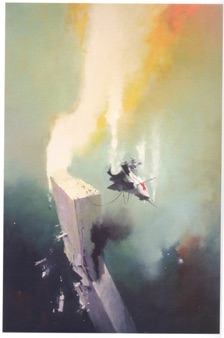 John Harris has produced book covers for many science fiction authors including famous names such as John Scalzi, Ben Bova, and Orson Scott Card. In fact, Scalzi himself, calls the artist’s work highly iconic, the phrase he uses is “Bookstore Iconic – which is to say it can be seen from across the bookstore.†(Harris p4) It is bold, striking, intense art that guarantees a good read. John Harris has also illustrated online fiction and produced artwork for NASA.
John Harris has produced book covers for many science fiction authors including famous names such as John Scalzi, Ben Bova, and Orson Scott Card. In fact, Scalzi himself, calls the artist’s work highly iconic, the phrase he uses is “Bookstore Iconic – which is to say it can be seen from across the bookstore.†(Harris p4) It is bold, striking, intense art that guarantees a good read. John Harris has also illustrated online fiction and produced artwork for NASA.
Harris is one of the few commercial artists working today who dislikes the nature of computer enhanced art (he calls it a bloodless medium) yet he has, however, produced some pieces in this manner. By taking the richly coloured roughness of his pastel sketches as starting points, so that the full bodied nature of his tangible pieces shines through, he develops them digitally by only a little. He is particularly fond of pastels as a medium, due to their hazy, atmospheric quality, which is, in fact, one of the key aspects of his art – the heightened sense of atmosphere his pictures evoke.
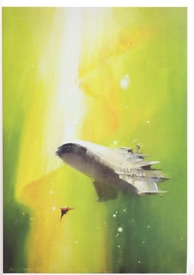 In the forward to a recent book on his work The Art of John Harris: Beyond the Horizon, the Author John Scalzi, whom the artist had painted book covers for, comments that: “quintessential John Harris art [is]: vibrantly coloured, impressionistic, yet technical, implying a whole universe outside the borders of the cover.†(Harris p4) In fact one of the most powerful aspects of the artist’s work is its obvious impressionistic influence “recalling, oddly, the romantic tradition of the 19th Century artists.†(Harris p4) John Harris is, perhaps, what Turner might have become, had he lived in the space age, or some future world.
In the forward to a recent book on his work The Art of John Harris: Beyond the Horizon, the Author John Scalzi, whom the artist had painted book covers for, comments that: “quintessential John Harris art [is]: vibrantly coloured, impressionistic, yet technical, implying a whole universe outside the borders of the cover.†(Harris p4) In fact one of the most powerful aspects of the artist’s work is its obvious impressionistic influence “recalling, oddly, the romantic tradition of the 19th Century artists.†(Harris p4) John Harris is, perhaps, what Turner might have become, had he lived in the space age, or some future world.
The artist is particularly interested in the depiction of mass and in capturing the sensation of “floating yet having weight.†(Harris p16) This can be produced in many different ways; by a juxtaposition of motifs, such as lines of steam escaping from a spaceship which implies a sense of falling, or by using a background of ‘hanging’ curtain-like nebula, in front of which a spaceship may a appear to rise (its nose tilted up).
Yet, the believability of his paintings of massive objects hanging in space “are not simply the result of knowing about the lack of gravity in space, but are the result of actual bodily experiences of weightlessness in transcendental meditation…[other images] were provoked by things witnessed in lucid dreaming.†(Harris p8) In fact John Harris studied meditation for six years after graduating from art school in Exeter. (Eldred)
He is inspired to create the art he does by having grown up among “the ruins of abandoned bunkers and jetsam of industrialised society†(Harris p34) after World War II. Playing around abandoned airfields also inspired many of his images with a curious melancholy which is, perhaps, reflective of that time: what the artist calls: “images of aspiration and fall†(page 34)
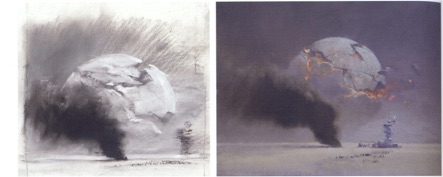
On the one hand there is hope that was seen as the progress of science – taking Man into space at last; and on the other the ominous, oppressive uncertainty of the cold war, “as if the heart already knows the emptiness that is yet to come.†(Harris p36)
Some of his most iconic paintings are those of his shattered moons, which emphatically highlight the artist’s delight in mass and scale as well as in “the end of things†(Harris p66) – the final demise of a world or a race, its last moment that only an artist can capture imaginatively (since one cannot live it). Yet on a lighter note the artist admits that: “there’s much that might precede that finality, involving all sorts of cracking, thumping and good old-fashioned explosions. Quite apart from anything else, they are fun to paint.†(Harris p66)
In the late 70’s Harris began painting a number of pieces which he associated together, which became an intriguing conceptual project. These became known as the ‘Rite of the Hidden Sun Paintings’, centring round an imaginary event which takes place during a solar eclipse on another planet. This is an ongoing project that the artist has been continually engaged in, and so far incorporates over 70 pieces of art, including text.
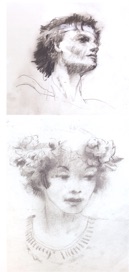 The premise for the paintings is that: “in the 19th Century, artists from Europe travelled to all sorts of exotic places across the globe, bringing back paintings to a public who had never seen images of the pyramids or the walled cities of Asia.†(Harris p96) Since this is no longer possible in a globalised world, Harris began to imagine that he was an artist who was “travelling in an old-fashioned way…towards the fabled city of Nandagni†(Harris p96) – the city of fire – recording in his sketchbook wondrous sights and landscapes from his imaginary world in impressionistic style. The bright sunlight and stark purple shadows, the hasty sketch-like depictions of fabulous buildings – towers, bridges, walls – and mountains like the mysterious Core. For the city itself is built atop a volcano which is regulated by an ancient technology known only to the ruling classes and revealed to new initiates in a dangerous rite of passage – a descent into the volcano’s mouth riding upon a silken blanket which is borne up on the thermal currents of air from within.
The premise for the paintings is that: “in the 19th Century, artists from Europe travelled to all sorts of exotic places across the globe, bringing back paintings to a public who had never seen images of the pyramids or the walled cities of Asia.†(Harris p96) Since this is no longer possible in a globalised world, Harris began to imagine that he was an artist who was “travelling in an old-fashioned way…towards the fabled city of Nandagni†(Harris p96) – the city of fire – recording in his sketchbook wondrous sights and landscapes from his imaginary world in impressionistic style. The bright sunlight and stark purple shadows, the hasty sketch-like depictions of fabulous buildings – towers, bridges, walls – and mountains like the mysterious Core. For the city itself is built atop a volcano which is regulated by an ancient technology known only to the ruling classes and revealed to new initiates in a dangerous rite of passage – a descent into the volcano’s mouth riding upon a silken blanket which is borne up on the thermal currents of air from within.
The artist admits that “it has become something similar to a graphic novel, an illustrated diary of an artist’s travels through an unknown region.†(Harris p96) Yet even here there is a sense of melancholy, of abandonment, and of ruin slumbering beneath a restless sun.
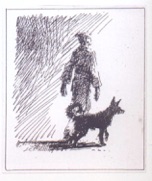 He even includes sketches of characters he ‘meets’ in his travels, creating a back story for himself as the artist Sol – including a ‘self’-portrait – characters such as the imposing Valve Keeper, The Valve Keeper’s Daughter, Mimu, and the mysterious figure of The Attendant: “To whom everybody in the city answered, but who was rarely seen (and then only with his dog).†(Harris p128)
He even includes sketches of characters he ‘meets’ in his travels, creating a back story for himself as the artist Sol – including a ‘self’-portrait – characters such as the imposing Valve Keeper, The Valve Keeper’s Daughter, Mimu, and the mysterious figure of The Attendant: “To whom everybody in the city answered, but who was rarely seen (and then only with his dog).†(Harris p128)
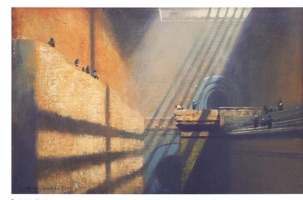 There are numerous detailed and yet hazily atmospheric depictions of the machinery within the core. The great sinks and conduits where lava is channelled and drained away after an eruption, and other remnants of abandoned technology litter the area near the city – such as the ‘sunflowers,’ gigantic towers, “evidence of an ancient but sophisticated solar technology†(Harris p98) which move fitfully, still, when the sunlight strikes them.
There are numerous detailed and yet hazily atmospheric depictions of the machinery within the core. The great sinks and conduits where lava is channelled and drained away after an eruption, and other remnants of abandoned technology litter the area near the city – such as the ‘sunflowers,’ gigantic towers, “evidence of an ancient but sophisticated solar technology†(Harris p98) which move fitfully, still, when the sunlight strikes them.
For, the city of fire was built, according to the imaginary population of the region, upon an old geothermal station. The founding father of the city, Humming Cotl, was the first to take the leap into the volcano, when, during an eclipse, the valves were stuck and the bridge had collapsed. According to legends, during his descent he heard a curious hum that originated from the eclipsed sun and resonated within him. It was this moment of revelation which told him what he needed to do in order to prevent the threatened eruption and save the geothermal station from destruction.
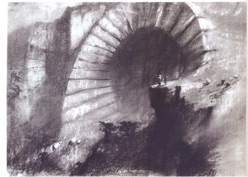 “The corona [of the sun] flared into view and, with it, his own mind burst into understanding. The mountain spoke to him.†(Harris p130) it was this epiphany which led to the formation of the Rite of the Hidden Sun.
“The corona [of the sun] flared into view and, with it, his own mind burst into understanding. The mountain spoke to him.†(Harris p130) it was this epiphany which led to the formation of the Rite of the Hidden Sun.
It is the juxtaposition of the spiritual culture of the ‘inhabitants’ of the city of fire, and their rigid reliance on ritual, with the science-fictional technology which creates a unique picture of a totally alien society. Recording it as an artist’s journey through the mysterious lands, invests the whole enterprise with a sort of surreal character. Everything is visualised with such clarity – there are even paintings of the same scene in daylight, evening light and moonlight, as an impressionist would paint, to capture the moods of the lighting – that the places seem like they actually existed (or do exist in some other reality, perhaps).
It is almost as if the artist had really travelled to the distant planet, when a far future Earth colony had been established there, in some time/space machine. And, perhaps in his lucid dreams he did – thus the power of imagination, which is all that limits what an artist can depict upon his canvas.
In praising the merits and diversity of this artist, I think that as an end note I should also add that, although science-fictional imagery was primarily what he produced, John Harris has also painted landscapes, inspired by his native Devonshire countryside, and even experimented with abstract works. These latter were largely inspired by NASA’s satellite pictures of the Earth from space, culminating in a series of paintings which he calls ‘the Secret History of the Earth.’ A departure, and yet, fittingly, a continuation of the imaginative exploration of one of the most talented artists to work in the field of science fiction art.
References
Harris, John, the Art of John Harris: Beyond the Horizon (2014)
www.alisoneldred.com/biogJohnHarris.html
Image Credits
All images used by permission of the artist
http://www.alisoneldred.com/artistJohnHarris.html
Leave a Reply
You must be logged in to post a comment.
